Biologické zotavení z acidifikace a saturace ekosystémů dusíkem (Level III)
Jiří Kopáček
Biologické centrum AV ČR, Hydrobiologický ústav
Publikace
Monitoring program of the study is focused on factors responsible for atmospheric acidification and N-fertilization of catchments of the Bohemian Forest lakes (Plešné – PL, and Čertovo – CT; Fig. 1), and the related ecosystem responses to these stressors, e.g., elevated nitrate (NO3–) leaching after saturation of the ecosystem by N, accompanied by nutrient depletion of soils (calcium – Ca, magnesium – Mg, and potassium – K) and aluminium (Al) toxicity to plant roots and aquatic biota.
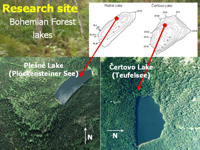
Fig. 1. Plešné and Čertovo lakes in the Bohemian Forest (border area between the Czech Republic, Germany, and Austria).
The study is based on mass budgets of major elements and their major fluxes within the catchment lake systems (for the research infrastructure at PL see Fig. 2). The element fluxes include inputs by atmospheric deposition (monitored in 2–4-week intervals at three plots in each catchment; one open area without trees and throughfall sites at the lake elevation and near the summit at ~200–300 m higher elevation), input by all major inlets (4 at PL and 7 at CT), output at a calibrated weir (monitored in 1–3-week intervals), and the element concentrations along the water column profile and in the sediments (monitored irregularly, mostly in summer). Each catchment is equipped with automatic weather station and soil and air registration thermometers at all throughfall (TF) plots. There are 5 quadratic frame traps (80 × 80 cm, height of 15 cm) situated beneath five representative trees at each TF plot for litter sampling, and traps with ionic resin in soil for measurement of NO3– and NH4+ fluxes below the litter and the uppermost mineral soil horizons.
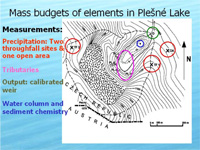
Fig. 2. Research infrastructure at PL Lake. Automatic weather station and discharge registration at a calibrated weir are situated at lake outlet. Research forest plots are identical with those for throughfall sampling (TF1 and TF2). OA, open area for sampling of bulk deposition. Blue circle, area of the maximal lake depth.
The major factor responsible for the current soil and water acidity and the elevated NO3– leaching is a cumulative effect of atmospheric deposition of sulphur (S) and oxidized (NOx) and reduced (NH3) nitrogen compounds. Fig. 3 shows reconstructed emission trends of S and N compounds in the Czech Republic. Similar trends occurred also in other Central European post-communist countries, like former Eastern Germany, Poland, Slovakia and Hungary. Emissions of all pollutants sharply increased after the 2nd World war and, then, they have rapidly declined since the late 1980s due to political and economical changes in the region. S emission has declined almost 90% during the last 2 decades due to a reduction in energy production and development of emission controls. But, the most exceptional changes compared to other World regions were almost 50% declines in both oxidized and reduced N forms due to optimisation of combustion regimes and reduction in cattle production. Such a decline in N emission has occurred only in Central Europe and the adjacent lake districts (including the Bohemian Forest) have become a valuable “test-tube” for N-studies. The historical changes in S and N emissions and depositions were the major driving force for long-term changes in lake water chemistry.
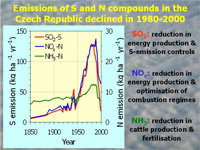
Fig. 3. Emissions of SO2, NOx, and NH3 in the Czech Republic in the 1850–2000 period.
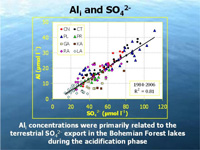
Fig. 4. Concentrations of SO42– and Ali in the Bohemian Forest lakes in the 1984–2006 period. Abbreviations: CN, Černé Lake; PL, Plešné Lake; GA, Grosser Arbersee; RA, Rachelsee; CT, Čertovo Lake; PR, Prášilské Lake; KA, Kleiner Arbersee; LA, Laka Lake.
Due to the high S emission and deposition in the Czech Republic, concentrations of ionic Al forms (Ali) were primarily related to the terrestrial export of sulphate (SO42-) in the Bohemian Forest lakes during the acidification phase (Fig. 4). Sulphate leaching explained 81% of the observed temporal and spatial variability in the lakes. Nevertheless, SO42– leaching from the Bohemian Forest soils has significantly declined after reduction in SO2 emissions, whereas that of NO3– remained high (Fig. 5-left). The relationship between S input and output from the CT catchment exhibits a significant hysteresis effect compared to the 1:1 line, with the current leaching substantially higher than that at the beginning of the 20th century at the same level of S deposition. Nevertheless, the soil pools of S are relatively small in the catchments of Bohemian Forest lakes (compared to other regions) and the SO42- leaching is well predictable, with no anomalies related to climatic conditions. A new equilibrium between S input and output will be reached within about next 50 years. In contrast, NO3– concentrations were negligible in the 1930s and increased around the 1950s, when N deposition exceeded 70 mmol m–2 yr–1 (10 kg N ha–1 yr–1). NO3– leaching declined after the decline in N deposition, but the catchment remains N-saturated and the current NO3– leaching is higher than that in the 1960s at similar N deposition rate (Fig. 5-right). Extremely high N-exports, exceeding N deposition, occurred in 1986 and 1996 after severe winters, in 2004 after extremely dry and hot summer 2003, and in 2005–2007 after forest dieback due to bark beetle infestation in the catchment. This suggests that the N-saturated catchments sensitively response to climatic and biotic disturbances by high NO3– leaching, that may in some cases exceed atmospheric input of inorganic N.
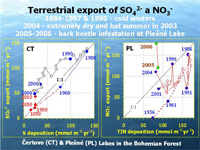
Fig. 5. Input and output fluxes of S and inorganic N in catchments of the Bohemian Forest lakes. Left: “S leaching from” versus “S deposition to” the catchment of Čertovo Lake. The blue points are based on measured data, red points and lines are simulated by model MAGIC. Right: “NO3– leaching from” versus “NH4-N + NO3-N deposition to” the catchment of Plešné Lake.
Elevated terrestrial NO3– export, following climatic anomaly (hot and dry summer 2003) and forest dieback (2005–2007), is associated with high leaching of ionic Al and soil losses of base cations (Figs. 6 and 7). Nitrate has become the dominant strong acid anion and its (so far unpredictable) leaching governs Al toxicity of soil solutions and surface waters, depletes soil base saturation, and delays soil and water recovery from acidification.
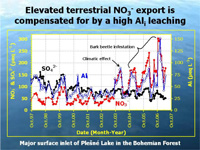
Fig. 6. The 1998–2007 trend in SO42–, NO3–, and Ali concentrations in the major inlet of Plešné Lake. Elevated terrestrial export of NO3– results from hot and dry summer 2003 and forest dieback (since 2004).
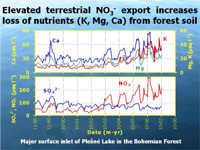
Fig. 7. The 1998–2007 trend in Ca2+, Mg2+ and K+ concentrations in the major inlet of Plešné Lake as a response to changes in terrestrial SO42– and NO3– export.